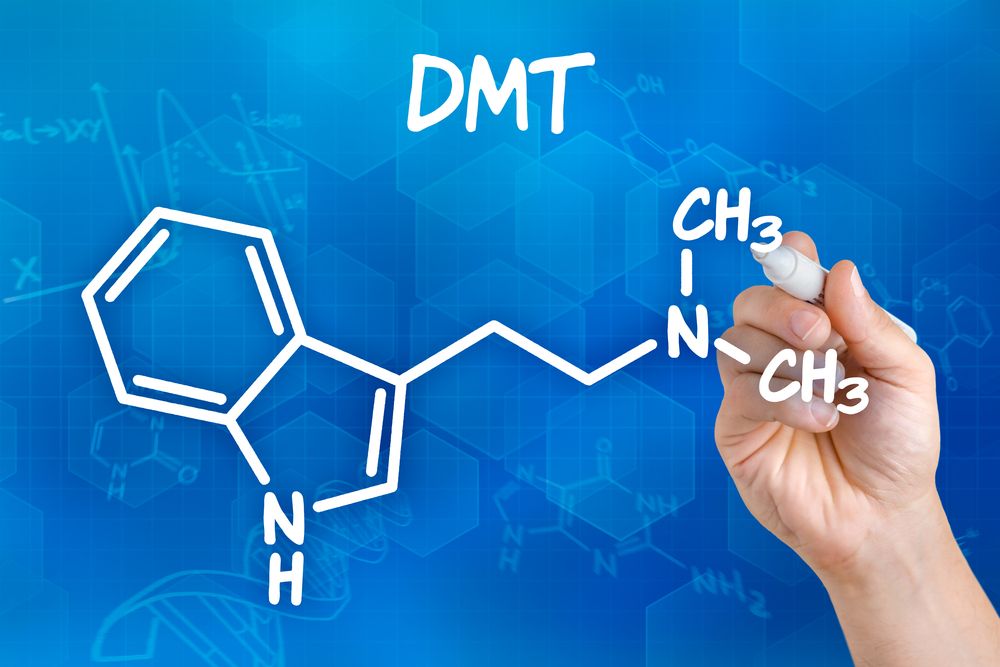
N, N-Dimethyltryptamine (DMT) is a psychedelic compound that belongs to the serotonergic class of psychedelics, which includes psilocybin (the active ingredient in “magic mushrooms”) and lysergic diethylamide (LSD).1 DMT, akin to all other serotonergic psychedelics, reliably evokes a multitude of subjective effects on brain functions such as cognition, perception, and affect (emotions).2
In the last couple of decades, there has been much debate within the scientific community over whether the mammalian brain produces DMT endogenously. And if so, is the compound produced in sufficient quantities to initiate the remarkable psychoactive effects observed when administered exogenously?3 A debate has also ensued concerning the role of the pineal gland – a tiny neuroendocrine organ in the brain whose primary function is nighttime secretion of melatonin – in the synthesis of DMT.3 This article will give a brief overview of the history and current findings of DMT biosynthesis and will also aim to contextualize these findings.
The Historical Context of DMT
Archaeological findings suggest that DMT usage dates back at least 1000 years, specifically amongst tribes in the Bolivian Andes.4 To this day, the native inhabitants of the Andean states use the DMT-containing brew, ayahuasca, for ceremonial purposes. Ayahuasca ceremonies are carried out by experienced shamans, who lead the participants into a deep state of psychological introspection.
In relation to Western culture, DMT was first synthesized in 1931 by Canadian chemist Richard Manske.5 However, the psychoactive properties of DMT were not discovered until 1956 by Hungarian chemist, Stephen Szara.6 Szara extracted DMT from the Mimosa hostilis plant and administered the extract to himself intramuscularly. This event established the connection between modern science and the sacred, cultural tradition of DMT usage.
The pineal gland has been associated with mysticism and spirituality throughout antiquity. For instance, in ancient Egypt, the pineal gland was believed to represent the eye of the sky god, Horus. French philosopher René Descartes (1596-1650), thought that the pineal gland represented a briding point between body and mind. Furthermore, Hindu culture represents the pineal gland as the third eye of enlightenment.
But how does DMT relate to the pineal gland? Rick Strassman, the most prominent figure in the modern DMT research community, postulates a link between DMT and the pineal gland. Strassman, a professor of psychiatry at the University of New Mexico, introduced DMT to the mainstream with his 2000 book, “DMT: The Spirit Molecule.” In this book, Strassman posits that the pineal gland secretes large amounts of DMT during strenuous life episodes, the most prominent of which are birth and near-death experiences. However, Strassman’s claims have been hotly debated based on factors such as biosynthesis and bioavailability of DMT.
DMT Biosynthesis
Biosynthesis of DMT is illustrated in Figure 1. It is dependent on the action of two enzymes: aromatic-L-amino acid decarboxylase (AADC) and indolethylamine-N-Methyltransferase (INMT). First, the dietary amino acid tryptophan is converted to tryptamine via the action of AADC. Tryptamine then undergoes N, N-dimethylation. Following this, the synthesis of DMT from tryptamine requires double methylation reactions catalyzed by INMT.
A recent study that has garnered much media attention around the world demonstrated, for the first time, the co-expression of both IMNT and AADC in the cerebral cortex of the mammalian (rat) brain.7 This finding is crucial as it provides a credible process for endogenous synthesis of DMT in the mammalian neocortex. In fact, the research group detected DMT at slightly lower (average 1.02 nM) concentrations than the known monoamine neurotransmitters such as serotonin (average ~2nM).

Figure 1. Biosynthesis pathway of DMT.3
The study also shed light on the involvement of the pineal gland in the biosynthesis of DMT. The study did this by demonstrating similar levels of extracellular DMT in animals with or without the gland. These results suggest that biosynthesis of DMT is not dependant on the pineal gland.
Critics of Strassman have challenged the hypothesis that the pineal gland can produce enough DMT to induce an out of body experience. It would need to produce about 25 mg of DMT very rapidly (over the course of no more than a minute or two).3 The daily secretion of melatonin from the pineal gland is roughly 30 µg, about 0.001 of the weight of DMT needed to induce such “mystical” states. Taken together, the findings mentioned above suggest that the pineal gland lacks the ability to produce DMT at levels originally proposed by Strassman.
Summary
Frequently in science, experiments that produce robust results don’t resolve a debate but instead lead to more questions. Strassman’s claim that the mammalian brain has the capacity to endogenously synthesize DMT seem to have been substantiated. However, the same experiment appears to refute his claim that the pineal gland is the brain structure responsible for DMT synthesis. If anything, this experiment represents a stepping to stone, which will enable the scientific community to further our understanding of the complex pharmacodynamics of DMT. It is refreshing that in today’s scientific climate, the stigma of psychedelic research is slowly lifting, allowing for an evidence-based inquiry into such topics.
Nice, hope we learn more soon; and hopefully more research is coming and the government (FDA) gets out of the way.
Why is 25mg bar for an exogenous dose sufficient? My understanding is that if you some that amount of dmt you will have the obvious effects–but I imagine much of, if not most of, the dmt fails to pass from the pipe to your lungs to your blood stream and then finally across the blood brain barrier.
If the dmt was in your brain from the start, one would think you would need much much less of the actual molecule to have any effect.